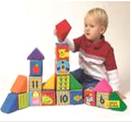题目内容
阅读下列短文,根据短文内容,完成文章后面的任务。

Building blocks(积木) are still one of the most popular traditional toys today.Their interesting design and easy use attract children of all ages.Most traditional toys, like building blocks, were first made of wood.Today, wooden building blocks are still used, but now there are several other types of building blocks to choose from, like plastic building blocks.
①Children build all kinds of things that they see in everyday life _________ building blocks. This gives them the ________ to learn new things and life skills.
②Building blocks can help children to practice their language skills. Most children talk to each other as they build things with these traditional toys. This type of toy also helps develop the skills that children need in life. As they begin to join groups playing with building blocks, they learn to take turns, to share, and to solve problems with others. However, these are not the only advantages of playing with building blocks. The building blocks also help develop children’s skills in math and science. They allow children to work according to the steps of scientific discovery, which are first to watch and think, and then to test. Traditional toy building blocks also come in different shapes, colors and sizes. These types of building blocks encourage children to develop skills in dividing things. Playing with building blocks is not just fun but also very helpful. So people around the world like them.
小题1:回答下列问题:What were traditional toy building blocks made of?
_______________________________________________________________________________
小题2:在①的空白处填入适当的单词使句意完整、上下文通顺:__________
小题3:将②处翻译成汉语________________________________________________________________
小题4:找出文中与下列句子意思相近的句子:
It is both fun and helpful to play with building blocks.
_______________________________________________________________________________
小题5:在文中找出最能表达该短文主题的句子:
______________________________________________________________________________

Building blocks(积木) are still one of the most popular traditional toys today.Their interesting design and easy use attract children of all ages.Most traditional toys, like building blocks, were first made of wood.Today, wooden building blocks are still used, but now there are several other types of building blocks to choose from, like plastic building blocks.
①Children build all kinds of things that they see in everyday life _________ building blocks. This gives them the ________ to learn new things and life skills.
②Building blocks can help children to practice their language skills. Most children talk to each other as they build things with these traditional toys. This type of toy also helps develop the skills that children need in life. As they begin to join groups playing with building blocks, they learn to take turns, to share, and to solve problems with others. However, these are not the only advantages of playing with building blocks. The building blocks also help develop children’s skills in math and science. They allow children to work according to the steps of scientific discovery, which are first to watch and think, and then to test. Traditional toy building blocks also come in different shapes, colors and sizes. These types of building blocks encourage children to develop skills in dividing things. Playing with building blocks is not just fun but also very helpful. So people around the world like them.
小题1:回答下列问题:What were traditional toy building blocks made of?
_______________________________________________________________________________
小题2:在①的空白处填入适当的单词使句意完整、上下文通顺:__________
小题3:将②处翻译成汉语________________________________________________________________
小题4:找出文中与下列句子意思相近的句子:
It is both fun and helpful to play with building blocks.
_______________________________________________________________________________
小题5:在文中找出最能表达该短文主题的句子:
______________________________________________________________________________
小题1:Wood./They were made of wood.
小题2:with, chance
小题3:积木能帮助孩子们练习语言技能。
小题4:Playing with building blocks is not only fun but also very helpful.
小题5:Building blocks(积木) are still one of the most popular traditional toys today.
小题1:从第一段的句子:Most traditional toys, like building blocks, were first made of wood.可知答案是Wood./They were made of wood.
小题2:第一句话是:孩子们可以用积木搭建日常生活中看见的东西。用with, 第二句话是:他们有机会学习新的东西:chance
小题3:这句话是动名词做主语,还有词组help sb to do sth:积木能帮助孩子们练习语言技能。
小题4:两句话的意思都是:玩积木不仅好玩而且有帮助:Playing with building blocks is not only fun but also very helpful.
小题5:文章的第一句话是主题句:Building blocks(积木) are still one of the most popular traditional toys today.

练习册系列答案
相关题目